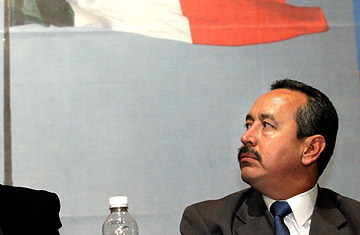
Mexico's former anti-drug czar Noe Ramirez has been accused of taking money from the Sinaloa Cartel
Few rituals are more futile than the "housecleaning" of Mexico's police forces. So deep, broad and brazen is cop corruption south of the border that removing it makes eradicating rats from landfills look easy. Mexico stages quasi-annual purges of officers high and low — last year it was 284 federal police commanders — and yet every year the nation seems to find itself with an even more criminal constabulary. This year's scandals, however, are especially appalling.
Over the summer, President Felipe Calderón's antidrug czar, Noe Ramirez, resigned abruptly. The likely reason became apparent this week after Ramirez was detained by federal officials and accused of taking $450,000 to keep Mexico's most powerful narco mafia, the Sinaloa Cartel, informed about police antidrug operations. He is the highest-ranking government official to be nabbed in this year's anticorruption sweep. (See pictures of crime-fighting in Mexico City.)
But not the only one. Last month five top officials at the federal organized-crime task force were collared for the same crime after being fingered by an informant who, astonishingly, worked for both the U.S. embassy in Mexico City and the Sinaloa narcos. Days later federal police chief Gerardo Garay — whose predecessor, Edgar Millan, was murdered by narco hit men last May, allegedly with the aid of a federal cop — resigned after being linked to a Sinaloa capo. Mario Velarde, a top boss of the federal police force's antidrug unit and a former private secretary to Garcia Luna, was also detained this week, for leaking info to the narcos. Ramirez and all the accused deny the charges. But as one federal security analyst says, it's no longer strange in Mexico's police purges "to see today's butchers become tomorrow's cows."
Mexico's real carnage, meanwhile, gets ghastlier by the day. This year the nation has logged some 4,300 drug-related murders, and analysts fear that Mexico could double last year's record of 2,500. The spike in killing is largely due to the war Calderón declared last year on the drug cartels. He has deployed more than 25,000 federal army troops in the campaign, but the narcos have lashed out with insurrection-style violence against a harrowing number of law-enforcement officials, from beat cops to top cops like Millan, as well as prosecutors and judges. The cartels, whose homicidal repertoire includes an orgy of beheadings, upped the terrorist ante in September when they allegedly threw grenades into a crowded plaza in Michoacán, killing eight people. (See pictures from Mexico's drug wars.)
The cartels, which run a $25 billion-a-year trafficking industry in Mexico, have also intensified their campaign of co-opting police. Not that Mexico's woefully undertrained and underpaid cops are that hard a mark. But the relentless revelations of the breadth of the corruption — including allegations that officers under Mexico's Public Security Minister, Genaro Garcia Luna, were involved in high-profile kidnappings — seem to make a mockery of Calderón's efforts to stamp it out. "This is Calderón's Iraq," says Sergio Aguayo, a security expert at the Colegio de Mexico in Mexico City. "He declared war against the cartels, but he wasn't prepared for the size of the threat the cartels turned out to represent." Many cases in the latest purge, which is indeed called Operation Housecleaning, are based on the testimony of an unidentified cartel informant in U.S. custody. Still, Calderón faces critics who worry the arrests are an attempt by the Mexican President to find scapegoats for his antidrug quagmire and secure U.S. antidrug aid.
The cartels' ability to infiltrate officialdom has grown so convincing that many Mexicans have trouble believing the government's assertion that a fiery Learjet crash this month on a busy Mexico City avenue — which killed Calderón's Interior Minister and de facto Vice President, Juan Camilo Mourino, and top security adviser Jose Luis Santiago Vasconcelos — was an accident and not narco sabotage. That dwindling public confidence has done nothing to help the Calderón administration fend off the effects of the global economic crisis. This year the Mexican peso has lost about a fifth of its value against the U.S. dollar.
That is all the more reason why the U.S. and the incoming Obama Administration need to lend Mexico, America's third largest trading partner, a more serious hand in reforming and professionalizing its police forces. This year Washington approved $400 million for Mexico's antidrug fight in 2009, part of a three-year aid package known as the Merida Initiative. But critics say the plan focuses too much on interdiction hardware like helicopters and not enough on software like an overhaul of Mexico's police and judiciary — especially higher pay for cops, many of whom earn a measly $5,000 a year, and the creation of more modern investigative units. Without it, Calderón will continue to rely on his army in this fight, but in the long run, armies make for lousy drug-interdiction forces.
The police woes should also prompt the U.S. to take its own culpability for Mexico's narco-calamity more seriously. Even U.S. Ambassador to Mexico Tony Garza this week took issue with Washington's complacency about curbing gringo demand for cocaine and the smuggling of Yanqui guns to Mexican drug gangs. "The truth is, Mexico would not be at the center of cartel activity, or be experiencing this level of violence," Garza said in San Antonio, "were the U.S. not the largest consumer of illicit drugs and the main supplier of weapons to cartels."
Traveling in Chile this week, Calderón insisted that his government "is strongly committed to fighting against not only organized crime but the corruption that organized crime generates and that has become entrenched over years and perhaps decades in the structures of power." It would seem that he made good headway this week. But as those years and decades have all too often shown in Mexico, the corruption usually gets generated at a far greater rate than any government can keep up with.
